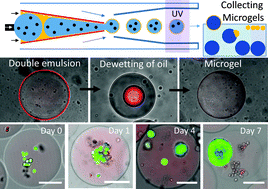One-step generation of cell-laden microgels using double emulsion drops with a sacrificial ultra-thin oil shell†
Abstract
Cell-laden microgels with highly uniform sizes have significant potential in tissue engineering and cell therapy due to their capability to provide a physiologically relevant three-dimensional (3D) microenvironment for living cells. In this work, we present a simple and efficient microfluidic approach to produce monodisperse cell-laden microgels through the use of double emulsion drops with an ultra-thin oil shell as the sacrificial template. Specifically, the thin oil shell in double emulsion spontaneously dewets upon polymerization of the innermost precursor drop and subsequent transfer into an aqueous solution, resulting in direct dispersion of microgels in the aqueous phase. Compared to conventional single emulsion-based techniques for cell encapsulation, this one-step approach prevents prolonged exposure of cells to the oil phase, leading to high-throughput cell encapsulation in microgels without compromising the cell viability. Moreover, this approach allows us to culture cells within a 3D microgel which mimics the extracellular matrix, thus enabling long-term cell functionality. This microfluidic technique represents a significant step forward in high-throughput cell microencapsulation technology and offers a potentially viable option to produce cell-laden microgels for widespread applications in tissue engineering and cell therapies.


 Please wait while we load your content...
Please wait while we load your content...